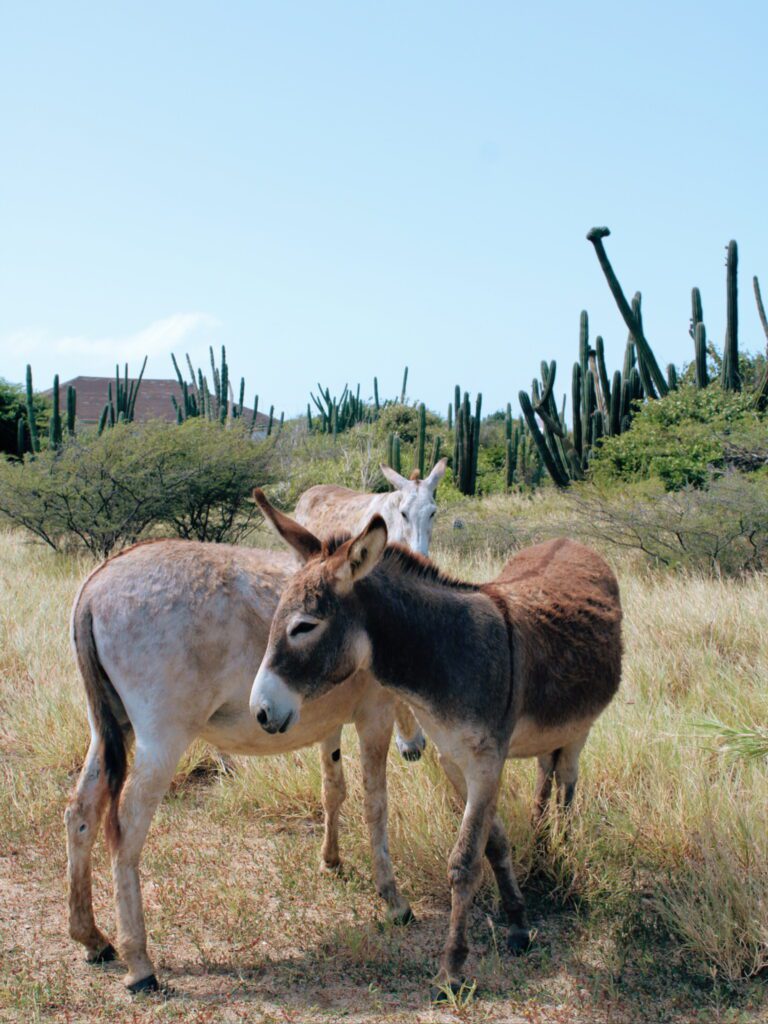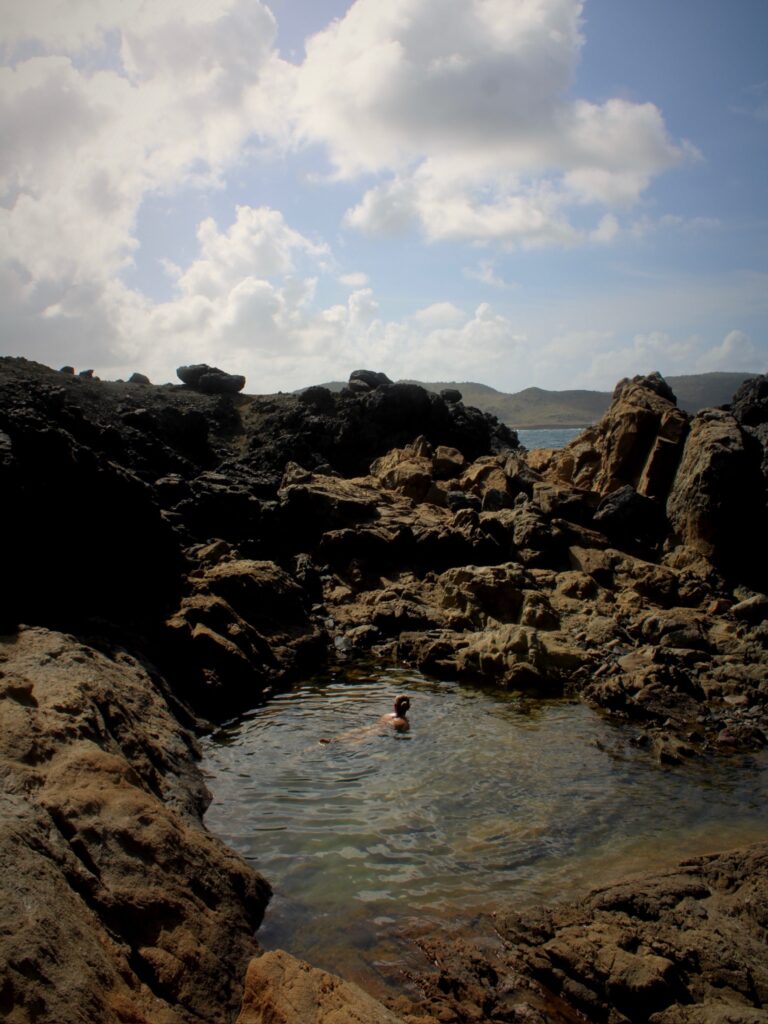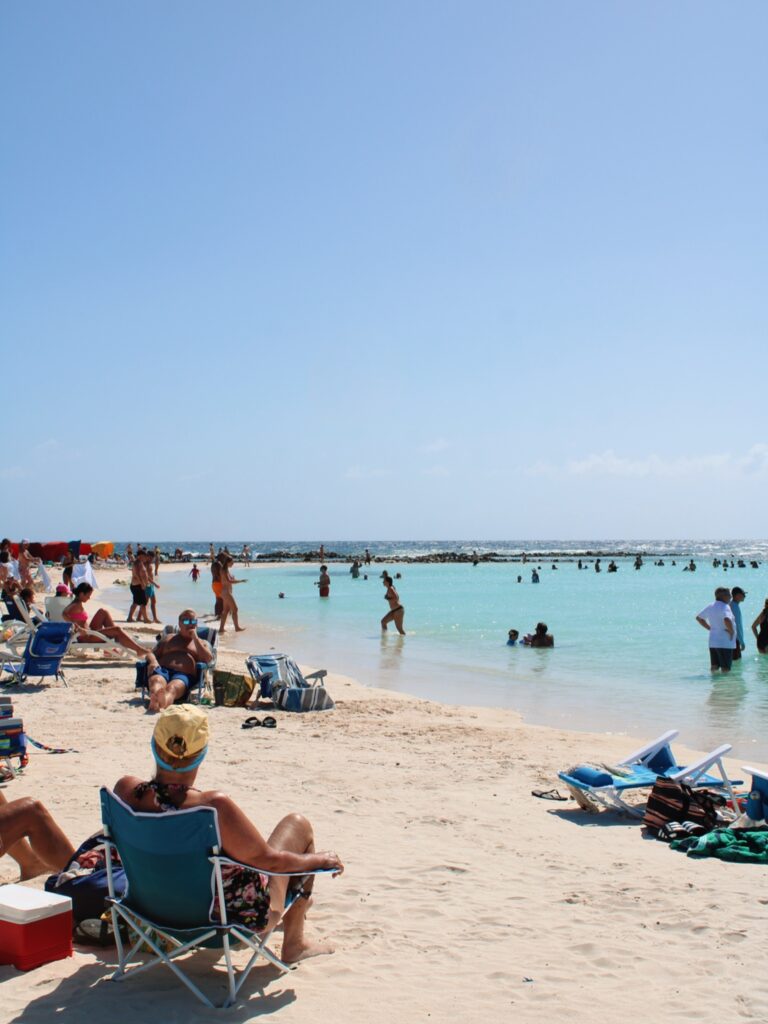Welcome to the ultimate guide to Aruba, the Caribbean’s hidden gem waiting to be explored! The island is known to be on the luxurious side of traveling. That’s why people tend to think the only way to visit the island is by paying for very expensive all-inclusive resorts. I visited Aruba in a completely different way to show you how you could also do it more affordably. From the colorful streets of Oranjestad to the rugged beauty of Arikok National Park, Aruba has a story worth seeing. Now, to help you make choices regarding your trip, let’s talk about everything there is to know about this island.
- Best Time to Visit: Climate, Crowds & Prices
- Local Culture: Cultural Norms, Aruban Community, Language
- Money Currency & Payments
- Accommodation Options
- Local Cuisine
- Transportation Options
- Safety & Health: Tap Water Conditions, Health Precautions, Emergency Informations, Safety Tips
- Visa Requirements
- Staying Connected: Getting a Sim Card in Aruba
- Top Attractions & Activities
1
Best Time to Visit
Climate
You may have heard it before, but it’s worth repeating—Aruba is sunny year-round! Temperatures hover between 80°F (27°C) during the cooler months and can climb up to 88°F (31°C) during the warmer months. It’s hot, but the constant breeze that sweeps across the island makes the heat more bearable. The wind helps balance out the temperature, but don’t let it fool you—sunscreen is a must, as the sun can be deceptively intense.
Aruba doesn’t really have a true rainy season. While it’s possible to experience a little rainfall between October and January, showers are typically brief and quickly followed by sunshine. Even during these months, you’re unlikely to see much rain—I visited in January and didn’t see a single drop!
Crowds & Prices
Since Aruba’s climate is consistently good, the best time to visit often depends on how busy you like your destinations. The high season runs from November to March, when the island sees more tourists and prices are at their peak. If you’re looking to avoid crowds and save some money, consider visiting during the low season, from April to October. No matter when you go, Aruba’s warm weather and charm make it worth the trip!
2
Local Culture
Cultural Norms
Arubans are known for their friendliness and laid-back attitude, and you’ll quickly notice how relaxed and welcoming the island feels. When visiting, it’s important to greet people with a smile and show respect to the locals. Arubans value politeness and hospitality, so don’t be surprised if strangers greet you warmly or strike up a conversation.
Aruban Community
Throughout my travels, I’ve encountered many local communities, but the Aruban people stand out as some of the best. They’re among the most kind, fun, and attentive individuals I’ve met. Whether it’s a waitress who feels like she’s on vacation too, a tour guide who keeps the group laughing, or a parking lot guard who checks on your evening, every interaction is infused with warmth and good humor. I didn’t meet a single unfriendly Aruban—they’re genuinely wonderful people!
The Language
Arubans are impressively multilingual, often learning five languages in school. The island’s primary spoken language is Papiamento, a unique Creole blend of Portuguese, Spanish, Dutch, and African influences. It’s the most common language for everyday conversations and business. In tourist areas, you’ll also hear plenty of English and Spanish, making communication easy for visitors. Dutch is used in government and education, and while Arubans learn French in school, don’t expect fluency. My French from Quebec puzzled them—they weren’t familiar with the accent! While they may understand standard French, it’s not commonly spoken.
3
Money Currency & Payments
When traveling to Aruba, having a good understanding of the local currency and payment methods will ensure a smooth and hassle-free experience. Here’s everything you need to know about managing money during your stay on the island.
Aruban Florin (AWG): The Local Currency
The official currency in Aruba is the Aruban Florin (AWG). However, U.S. dollars (USD) are widely accepted across the island, particularly in tourist areas. Many prices are even listed in both Florin and USD, making it convenient for American travelers. Despite this, having some local currency can be useful, especially in more local or rural areas.
Exchange Rates
The exchange rate for the Aruban Florin is relatively stable. Generally, 1 USD equals around 1.75-1.80 AWG. Make sure to check the current exchange rate before your trip to get an accurate idea of the conversion.
Currency Exchange
You can exchange currency at banks, hotels, or exchange counters. However, it’s often more convenient and cost-effective to withdraw money directly from an ATM. Some ATMs allow you to withdraw in either USD or Florin, but be aware of any foreign transaction fees that your bank may charge.
ATM Withdrawal Limits
ATMs are widely available in Aruba, especially in major tourist areas. Most machines allow a withdrawal of up to 500 AWG or the equivalent in USD per transaction. If you need more cash, you might have to make multiple withdrawals depending on the machine’s limit.
ATM Fees
Aruban ATMs may charge a withdrawal fee of around 5-10 AWG per transaction, in addition to any fees your home bank might apply. To minimize these fees, it’s better to withdraw larger sums at once rather than making multiple smaller withdrawals.
Security
Use ATMs located inside banks, hotels, or well-lit and secure areas. Always cover your PIN when entering it and be cautious of any suspicious devices attached to the machine.
Card Payments, Minimum Spend & Transaction Fees
Visa and Mastercard are widely accepted across the island, especially in tourist hubs, hotels, and restaurants. American Express and other cards may not be accepted in smaller establishments, so it’s a good idea to carry a backup card. Some shops or restaurants may have a minimum spend requirement for card payments, so always check before making a purchase. It’s also a good idea to confirm with your bank if they apply any foreign transaction fees, as these can add up during your trip.
Tipping Etiquette
Tipping in Aruba is generally appreciated but not always expected. In restaurants, a tip of 10-15% is common, though some places may automatically add a service charge to your bill. For hotel staff, a tip of 1-2 USD per bag for porters or a few dollars per night for housekeeping is a nice gesture. Taxi drivers don’t typically expect a tip, but rounding up the fare is considered polite.
4
Accommodation Options
Of course, you can opt for the convenience of all-inclusive resorts, but they tend to be quite pricey. Instead, we chose to stay in an Airbnb, which offers some truly unique and memorable accommodations. Many Airbnb properties are fully equipped like an apartment, with a fridge and a kitchen, so you can save money by cooking meals at your villa rather than dining out. This option is especially great for families or large groups, as you can split the cost and enjoy a more communal experience compared to staying in separate hotel rooms. It’s often more affordable and a lot more fun!
5
Local Cuisine
Aruba’s cuisine is a flavorful mix of Caribbean, Dutch, and Latin American influences, offering a variety of unique dishes.
- Keshi Yena: This hearty dish features spiced chicken baked in a shell of melted Dutch cheese, a must-try local favorite.
- Pastechi: Popular street food, these deep-fried pastries are filled with cheese, chicken, or seafood, perfect for a quick snack.
- Fresh Seafood: Enjoy fresh-caught fish like mahi-mahi, grouper, and wahoo, often grilled and seasoned with local spices.
- Funchi & Pan Bati: Traditional sides include Funchi (a cornmeal dish) and Pan Bati (a flatbread), often served with stews or seafood.
- Sopi: Local soups, such as Sopi di Pisca (fish soup) and Sopi di Jambo (okra soup), are hearty and packed with flavor.
- Dutch Influences: Aruba also has Dutch-inspired treats like pannenkoeken (pancakes) and croquettes, reflecting its colonial past.
- Local Drinks: Try Balashi, Aruba’s local beer, or an Aruba Ariba cocktail. For a non-alcoholic option, batidos (fruit smoothies) are refreshing and delicious.
Every meal I had in Aruba was fantastic. Restaurant prices range from affordable to high-end, though you won’t find many truly “cheap” options. If your accommodation has a kitchen, cooking your own meals is an option, but groceries aren’t much cheaper—unless you’re shopping for a large group or family.
We sampled a wide variety of dishes during our stay, but the seafood was a standout. I tried Mahi Mahi for the first time, and it was absolutely delicious. Be sure to check out [insert link or reference] for my favorite restaurants and must-try dishes in Aruba!
Stay connected! Follow us on social media for exclusive content & updates on our travels.



On our website, you’ll find all the essential information and tips, while on our social media, you’ll get even more – including personal experiences, funny moments, stunning videos, and much more!
6
Transportation Options
Although Aruba is a small island, it’s not quite walkable for getting to all the top attractions. To make the most of your visit, you’ll need some form of transportation. Choosing the right option depends on your itinerary, budget, and preferences. Here’s a breakdown of the available options:
1. Renting a Car:
This is what we chose, and it was ideal for exploring the island at our own pace. I do recommend booking in advance online to save money—waiting until the last minute can leave you with fewer, more expensive options. If you don’t pre-book, there are plenty of rental companies near the airport, though availability can be hit or miss.
2. Taxis:
Taxis are readily available and operate on fixed government rates. They’re a convenient choice if you’re not renting a car, especially for short trips or getting around at night.
3. Public Buses:
While we didn’t use the buses, they are said to be an affordable option, covering most major tourist areas. However, they’re not as flexible as having your own vehicle.
4. Bicycle Rentals:
Some hotels and rental shops offer bicycles, which are a fun and eco-friendly way to explore certain parts of the island. You won’t be able to see the whole island by bike, but you could combine biking with bus rides or taxis for a more flexible experience.
5. ATVs and Scooters:
For the adventurous, renting ATVs or scooters is a thrilling way to explore Aruba’s rugged terrain. ATVs, in particular, are perfect for discovering off-road spots like Arikok National Park. Several rental companies offer these options, adding a bit of excitement to your island adventure.
7
Safety & Health
When traveling to Aruba, it’s important to be aware of both safety and health precautions to ensure a worry-free experience. Below are three key areas to consider: tap water conditions, health precautions, and emergency information.
Tap Water Conditions
The tap water in Aruba is safe to drink. The island’s water is produced by a desalination plant and is considered some of the cleanest in the world. You can drink it straight from the tap without concern.
Health Precautions to Take
Staying healthy in Aruba is relatively straightforward, as the island has modern medical facilities and a low risk of major diseases. However, it’s still important to take a few basic precautions:
• Vaccination: Ensure you are up-to-date on routine vaccines like tetanus and hepatitis A before traveling. There are no mandatory vaccines required for Aruba.
• Sun Protection: Aruba’s sun is strong, and the cooling breeze can make it easy to underestimate how much exposure you’re getting. Use high-SPF sunscreen, wear hats and sunglasses, and stay hydrated to avoid sunburn or heat exhaustion.
Emergency Information
While Aruba is generally a safe and well-developed island, it’s good to be prepared for any unexpected situations.
Emergency Numbers
- Police: 100
- Ambulance: 911
- Fire Department: 911
- Tourist Assistance: 582-3777 (Tourist Police)
Keep these numbers handy, and always have a way to communicate in case of emergency.
Hospitals and Clinics
Aruba has excellent medical facilities. Dr. Horacio Oduber Hospital in Oranjestad is the island’s main hospital and provides comprehensive care. For minor medical issues, there are several clinics and pharmacies across the island. Be sure to have travel insurance that covers medical expenses, including possible evacuation if necessary.
Pharmacies
Pharmacies, known as “boticas,” are common in Aruba and carry a wide range of medications. They offer both prescription and over-the-counter drugs, so it’s easy to find what you need. However, if you require specific prescription medications, bring enough for your trip as availability can vary.
Language and Communication
English is widely spoken in Aruba, especially in medical facilities and tourist areas. Most medical staff will be able to communicate in English, making it easier for travelers to receive the care they need. However, it’s still helpful to have important medical information translated into Papiamento or Spanish if necessary.
Safety Tips
Aruba is known for being a safe destination, but as with any trip, it’s important to stay cautious. Solo travelers should be particularly mindful of their surroundings, especially at night or in less busy areas. For more detailed advice, check out our article Top Safety Tips for Solo Travelers: Stay Safe & Confident.
8
Visa Requirements
Before traveling to Aruba, it’s important to understand the visa requirements to ensure a smooth entry into the country. Below are the key points to consider regarding visas and entry requirements:
Who Needs a Visa?
Visitors from many countries, including the United States, Canada, and most European Union nations, do not need a visa for short stays in Aruba, provided the visit is for tourism and does not exceed 30 days. However, citizens from certain countries will need to apply for a visa before traveling. It’s best to check Aruba’s official immigration website or contact your nearest embassy to confirm the specific requirements based on your nationality.
Length of Stay
Tourists are generally allowed to stay in Aruba for up to 30 days without a visa. However, in some cases, stays can be extended to a maximum of 180 days per year, with special permission. If you’re planning to stay longer, you must apply for an extension through Aruba’s Department of Immigration.
9
Staying Connected: Getting a SIM Card in Aruba
Getting a local SIM card is an affordable and convenient way to stay connected during your trip to Aruba, ensuring you have access to mobile data and calls wherever you go.
Where to Buy a SIM Card
SIM cards in Aruba are readily available and can be purchased at the airport, local phone shops, or convenience stores. The two main mobile providers on the island are Digicel and Setar. Both offer prepaid SIM cards with various data and call packages to suit your needs.
How Much Does It Cost?
Prices for SIM cards vary depending on the provider and the package you choose, but you can expect to pay around $10-$20 USD for a basic SIM card, which usually includes some initial credit or data. Additional data and call packages can be purchased based on how much you plan to use your phone.
How to Activate a SIM Card
Activating your SIM card is easy. Most providers offer a plug-and-play service—just insert the SIM card into your unlocked phone, and it should automatically connect to the network. If activation is required, you can follow the instructions provided with the SIM card, or ask the staff where you purchased it for assistance.
Topping Up Your SIM
Topping up your SIM card is simple. You can buy top-up cards at convenience stores, supermarkets, or online through the provider’s website. Many shops display signs for phone credit, making it easy to keep your data or call balance topped up during your stay.
10
Top Attractions & Activities
Being such a small island, I didn’t think there would be so many things to do! Going from sports to relaxing on the beach or from museums to beautiful nature, there is something for everyone and all age groups. It can be the perfect place for a honeymoon as much as the perfect place for a family trip with young children.



Don’t want to miss out on our latest articles? Be sure to subscribe to our website, and you’ll receive a notification every time we publish something new!
